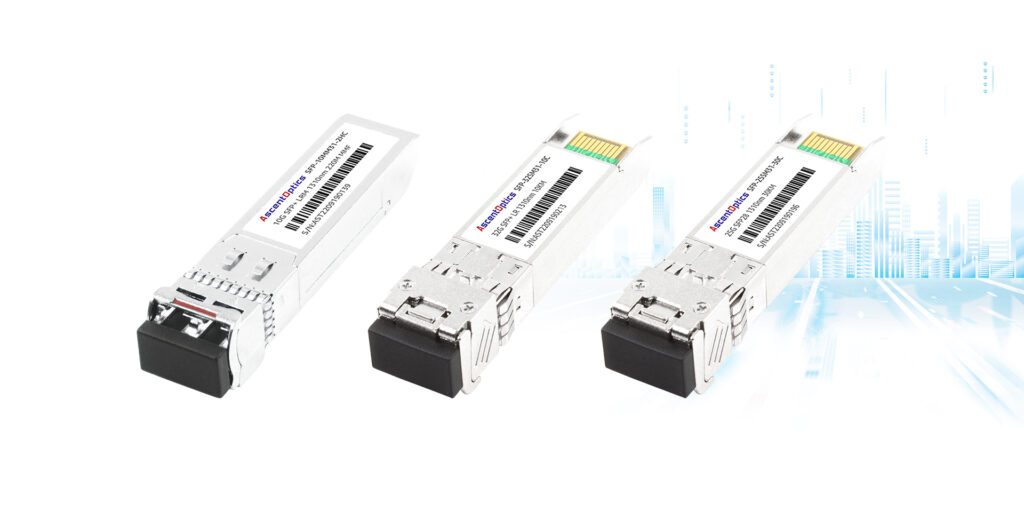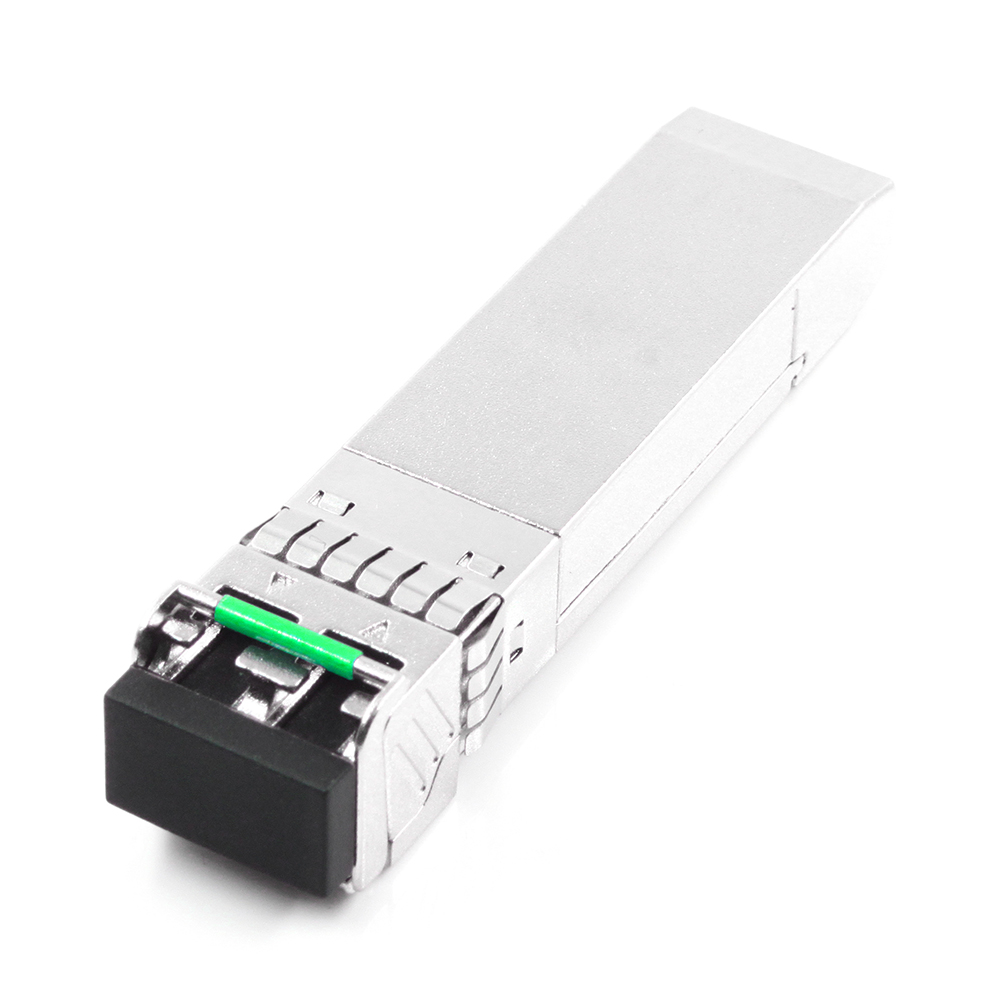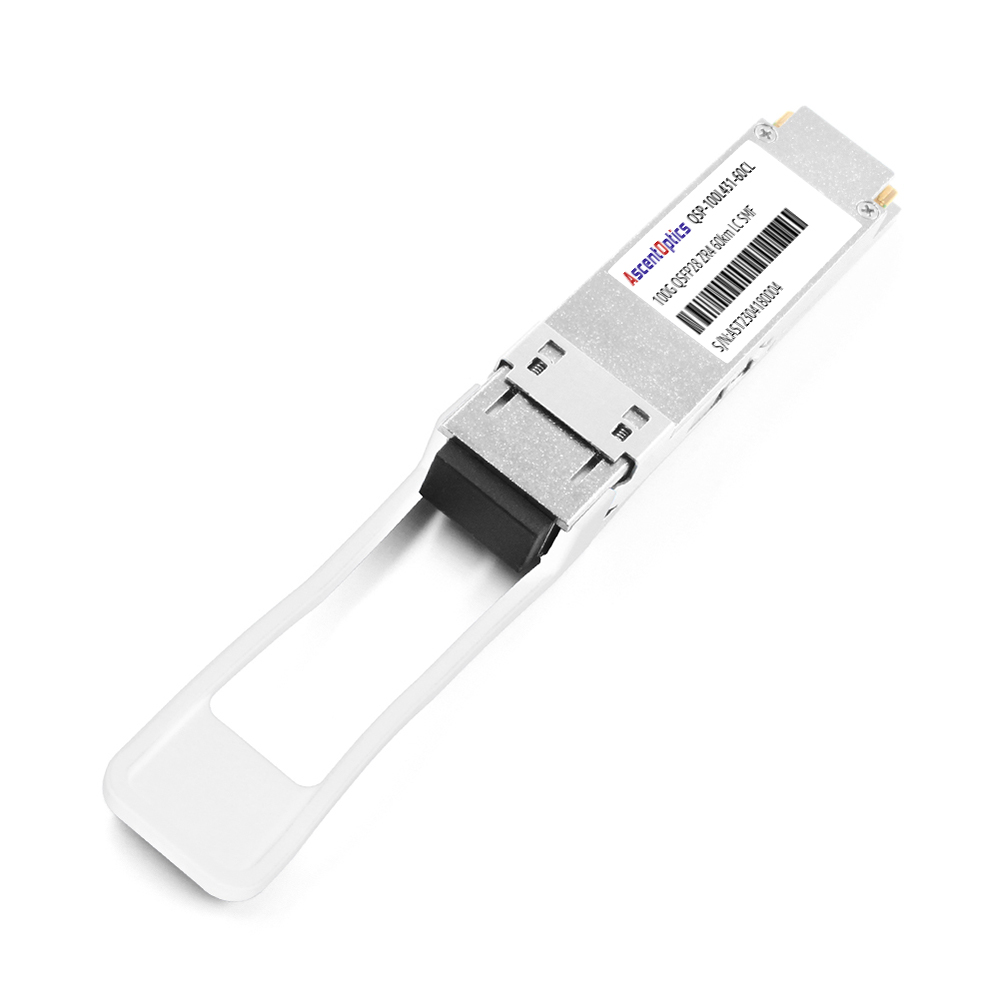
Optical modules are electronic devices that convert electrical signals into optical signals for transmitting data over an optical fiber. These modules typically consist of a transmitter, which converts electrical signals into a light signal, and a receiver, which converts the received signal back into an electrical signal.
Optical modules come in different types, each with unique characteristics that make them suitable for specific applications. The two primary types of optical modules are pluggable and embedded modules. Pluggable or hot-swappable modules can be easily inserted or removed from a networking device without shutting it down. Embedded modules, on the other hand, are permanently attached to a device.
Pluggable optical modules can be divided into small form-factor pluggable (SFP) modules and quad small form-factor pluggable (QSFP) modules. SFP modules are used in data networks to connect servers, switches, and routers. QSFP modules are designed for high-speed applications like data storage and high-performance computing. Embedded modules include basic, enhanced, and extended small form factor pluggable (SFP), quad small form factor pluggable plus (QSFP+), and CXP.
Optical module form factors refer to the physical dimensions of the module. The form factor determines the size and shape of the module and is essential for compatibility with other network devices. The most commonly used form factors include SFP, QSFP, SFP+, QSFP+, and CXP. SFP and QSFP are used for small and medium-reach applications, while SFP+ and QSFP+ are designed for high-speed data transfer over short distances. CXP is used for high-speed data transfer over long distances.
The type of cable used with an optical module depends on the application and the distance between devices. Multimode optical fiber is commonly used for short-distance applications, while single-mode optical fiber is preferred for longer distances. Copper cables are preferred for short distances, where cost and convenience are factors. Coaxial cables are used in high-frequency applications, including cable TV, broadcast TV, and video surveillance.
Recommended Products:40G QSFP+ SR 850nm/910nm 100m Bi-Directional Receiver Module
Optical modules are an integral part of data center networking systems. They enable high-speed, reliable data transfer between network devices, ensuring the optimum performance of critical applications. Optical modules also offer flexibility and scalability, allowing network administrators to upgrade their networks as their needs evolve. As data centers grow in complexity and size, optical modules will remain essential components for high-speed, reliable data transfers.

Optical modules are electronic devices that transmit data over long distances using light waves. They are used in networking technologies to facilitate data transmission from one device to another. Optical modules are small and compact in design, making them easy to install in any networking device. They are crucial in establishing an efficient data communication network.
Optical modules can transmit data signals over long distances without losing signal strength. The transmission distance and speed of optical modules are determined by their modulation technique, which is used to manipulate the light waves. The most common modulation techniques include amplitude, frequency, and phase modulation. The modulation technique will determine the optical module’s transmission speed and distance.
Optical module modulation is manipulating the light waves in an optical module. It is a crucial function that determines the transmission speed and distance of the optical module. Three main modulation techniques are used in optical modules: amplitude modulation, frequency modulation, and phase modulation. Each modulation technique has advantages and disadvantages and influences the overall performance of the optical module.
An optical module consists of several critical components that enable its optoelectronic process. These components include a transmitter, a receiver, a laser, a photodiode, a printed circuit board, and a connector. The transmitter and receiver are responsible for sending and receiving the light signals. The laser generates the light signal, while the photodiode detects the incoming light motion. The printed circuit board regulates the voltage and current, while the connector provides a stable connection.
Optical modules are available in various types to accommodate different network types and configurations. Some of the other network types include LAN, WAN, and SAN. Optical modules for LAN networks can transmit data at rates of up to 10 Gb/s, while those for WAN networks can transmit data over distances of up to 80 km. SAN optical modules are explicitly designed for storage area networks and can transmit data over long distances.
Optical modules use electrical signals to convert them into optical signals that can be transmitted over long distances. The electrical signals are returned to their original form at the receiver end. The visual interface plays a crucial role in the overall performance of the optical module. It ensures that the transmission is error-free and that all the necessary data packets are transmitted without any data loss. Diverse visual interfaces accommodate different networking needs, including single-mode, multimode, and polarization-maintaining fiber interfaces.

Choosing a suitable optical module for specific applications enhances network performance, reduces network downtime, and ensures smooth data transmission.
An important consideration when choosing optical modules is understanding the optical wavelengths basics. Optical wavelengths are the characteristics of light waves that carry information between devices. These wavelengths range from 850 to 1550nm, each with unique significance. For example, short-range transmission uses wavelengths between 850nm and 1300nm, while long-range communications use wavelengths above 1300nm. Therefore, understanding wavelengths is crucial in selecting the correct optical module to match the specific data transmission needs.
Single-mode and multimode optical modules differ in their structure and function. Single-mode modules have a narrower optical core that allows a single light pathway, while multimode modules have a broader body that simultaneously transmits multiple light paths. Each type has its specific applications and use cases, and selecting the right one depends on the distance covered and the data transmission speed required. Multimode modules are typically used for short-range transmission, while single-mode modules are preferred for long-range, high-speed data transmission.
Optical modules have different data transmission rates, and selecting the correct rate is essential to ensure efficient data transmission. Data transmission rates range from 2.5 Gbps to 400 Gbps, each suitable for specific applications. Therefore, businesses must assess their data transmission needs and select optical modules with the appropriate data transmission rate.
Specialized optical modules are available for high-speed networks. These modules are designed to provide unparalleled performance in terms of speed and accuracy. Such specialized modules include QSFP28, CXP, and CFP2. QSFP28, for example, is designed for 100 Gbps data transmission, while CXP lenses support 100 Gbps Ethernet applications. CFP2 modules are ideal for data centers and high-speed transmission over extended distances.
Finally, it is essential to ensure that installed optical modules are compatible and interoperable with the network switch and transmission media. Optical modules are produced in various form factors, and selecting the correct form factor that matches the button and patch cord type is crucial. Compatibility issues can lead to network downtime, and it can be costly to resolve the situation. Therefore, verifying that the installed optical modules are compatible and interoperable with the entire network infrastructure is essential.
In conclusion, selecting the correct optical module enhances network performance, reduces downtime, and ensures smooth data transmission. Factors to consider when choosing optical modules include optical wavelengths, single-mode or multimode modules, data transmission rates, specialized modules, and compatibility with the infrastructure. Considering these factors, businesses can optimize network performance, reduce downtime, and ensure efficient data transmission.

Optical modules are electronic devices used in communication systems to transmit optical signals. These modules convert electrical signals into optical signals, which can travel long distances without degradation. Optical modules are essential components of fiber optic networks used in various applications such as data centers, telecommunications, and aerospace. Proper installation and maintenance of optical modules are critical to ensure their efficient operation and long life. This guide will discuss installing, cleaning, troubleshooting, upgrading, and testing optical modules.
Installing plug-and-play optical modules in specific applications or devices requires few tools and equipment. Before installing, ensure you have a fiber optic patch cord, an optical module, and a compatible device or application. First, inspect and clean the visual connector interfaces to ensure no damage or dirt. Next, insert the optical module into the device’s compatible slot or port, and secure it with screws or clips. Finally, connect the fiber optic patch cord to the optical module and device or application. After installation, check the optical signal power and quality to ensure the optical module is transmitting as expected.
Optical connectors are critical components in communication systems and should be cleaned and cared for regularly to prevent signal loss and other issues. Optical connectors should be cleaned every time they are disconnected and reconnected. The cleaning process involves inspecting the connector end-face, using a dry cleaning cloth or swab to remove dust or debris, and wet cleaning if necessary. Wet cleaning involves using a cleaning solution and a lint-free cleaning swab to clean the connector end-face. Care should be taken when handling and storing optical connectors to prevent damage or contamination.
Optical module issues can prevent proper signal transmission during installation or maintenance. Some common problems include loss of signal power, connectivity issues, and module failures. If you encounter any of these issues, check the optical connector for damage or dirt, inspect the fiber optic patch cord, ensure the optical module is correctly installed, and check the device settings for compatibility. If these simple steps do not resolve the issue, contact the module manufacturer for more advanced troubleshooting steps.
Optical modules are scalable and can be upgraded to support higher data rates and longer distances. Upgrading optical modules involves replacing the module with a higher-capacity module or adding modules to the communication system. Care should be taken to ensure the upgraded module is compatible with the existing system and the system settings are appropriately configured.
Optical module testing and performance monitoring are critical for ensuring optimal system performance and detecting issues before they cause system failures. Testing and tracking involve using specialized equipment to measure signal power, quality, and other parameters. Regular testing and monitoring can help detect issues early, allowing you to take corrective action before significant system failures occur.

One of the most significant trends in optical modules is the continual improvement in optical transceiver technology. Optical transceivers are the primary components of optical modules responsible for transmitting and receiving optical signals over fiber optic cables. Recent innovations include using higher-speed lasers, greater signal modulation efficiency, and increased spectral bandwidth to enhance data rates and distance capabilities. For instance, quad small form factor pluggable (QSFP) transceivers with 400Gbps data rates are being developed to support emerging data center applications.
As network usage and data traffic grow, new data transmission standards are being developed to meet the demand for higher speed, increased bandwidth, and excellent reliability. For example, 400 Gigabit Ethernet (400GbE) and 800GbE standards are being developed to support high-performance computing, cloud-based applications, and edge computing. These standards require optical modules with higher data rates and greater power efficiency, which has led to advancements in optical transceiver technology, packaging, and design.
As optical modules become more integral to network infrastructure, smaller, more efficient, and flexible form factors are being developed. Small Form Factor Pluggable (SFP) modules have been widely used. Still, now, new module designs, such as Quad SFP (QSFP), Quad Small Form Factor Pluggable Double Density (QSFP-DD), and Small Form Factor Pluggable 28 Double Density (SFP28-DD), are becoming more prevalent. These new module designs provide higher data rates, greater power efficiency, and support for more protocols.
With the rapid growth of high-performance computing, cloud-based services, and other data-intensive applications, there has been a significant increase in demand for higher bandwidth and transmission rates. Optical modules supporting 400GbE or greater bandwidths are being developed to meet these growing demands. Along with greater bandwidth capacity, optical modules are being designed to operate optimally in harsh environments, using techniques such as error-correction coding and forward error correction to ensure data integrity.
Optical modules, such as 5G, edge computing, and the Internet of Things (IoT), are crucial in next-generation networks. Optical modules facilitate high-speed data transfer between remote locations, allowing real-time communication between devices, such as autonomous vehicles, medical devices, and intelligent appliances. Optical modules also enable efficient, high-bandwidth connections between data centers, improving the overall performance and reliability of the network. As these networks evolve, optical modules will be at the forefront of enabling faster, more efficient, and more reliable network connections.

A: Optical or transceiver modules convert electrical signals into optical signals and vice versa. They are used in optical communication systems to transmit and receive data over fiber optic cables.
A: Various optical modules are available, including SFP, SFP+, XFP, QSFP, CFP, and QSFP28. Each type has its form factor, electrical interface, and transmission rate. These modules are commonly used in data center environments.
A: An optical transceiver module combines a transmitter and a receiver in a single package. It converts electrical signals into optical signals for transmission through fiber optic cables and converts optical signals back into electrical signals for processing by network equipment.
A: Single-mode optical modules are designed to transmit optical signals over long distances, typically using a single fiber. Multimode optical modules are designed for shorter distances and can share data using multiple threads simultaneously.
A: The wavelength of an optical module refers to the color of light used to transmit data. Standard wavelengths include 1310nm, 1550nm, and 850nm, depending on the type and application of the module.
A: Optical modules are essential components in data center networks. They enable high-speed data transmission over fiber optic cables, connecting servers, switches, and other network equipment. They also support protocols and interfaces like Ethernet, Fibre Channel, and InfiniBand.
A: DWDM stands for Dense Wavelength Division Multiplexing. This technology allows multiple optical signals with different wavelengths to be transmitted simultaneously over a single fiber. DWDM optical modules are used to implement DWDM in optical networks, increasing bandwidth and capacity.
A: The maximum transmission distance of an optical module depends on various factors, including the module type, the quality of the fiber optic cables, and the transmission rate. Some optical modules support the long-distance transmission of up to several kilometers.
A: Hot-pluggable means an optical module can be inserted or removed from an active system without disrupting its operation. This feature allows for easy installation, maintenance, and upgrades of optical modules without powering down the equipment.
A: The numbers in the names of optical modules, such as 10G, 40G, 100G, and 400G, represent the data transmission rate in gigabits per second. Higher numbers indicate higher transmission rates, enabling faster and more efficient data transfer.